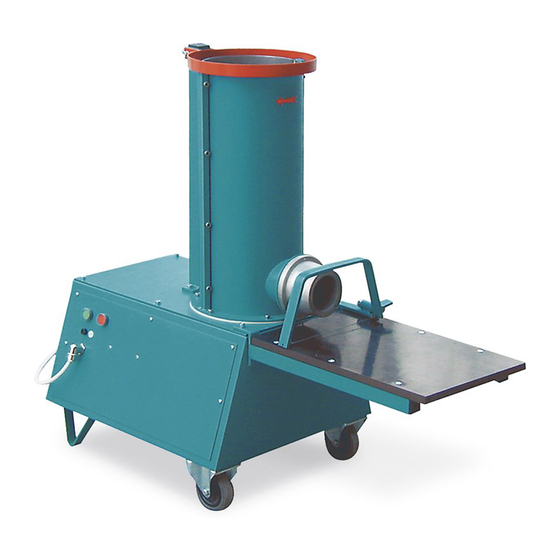
Rohde TS 20 Instruction Manual
Pugmill
Hide thumbs
Also See for TS 20:
- Instruction manual (28 pages) ,
- Original operating instructions (194 pages)
Table of Contents
Advertisement
Quick Links
Pugmill TS 20
Instruction Manual
Applications:
The ROHDE TS 20 is suitable for the processing and homogenisation of clays and porcelain
masses. It can also be used for mixing different masses together and the mixing-in of
fireclays. It is not suitable for processing clay flour with water in order to produce ceramic
masses. For those purposes a soaking pit or an extruder as closed systems are necessary.
Unpacking:
The ROHDE TS 20 is delivered on palette. The shelf is fastened to the mixing rod with
straps. Please take the ROHDE TS 20 off the palette first. Then detach the shelf from the
mixing rod. Remove other packing materials.
Installation:
Slightly lift your ROHDE TS 20 at the handle and roll it to the desired location. Remove the
fixation screws for the shelf entirely, hold the shelf to its position and fix it there with the
previously removed screws. Please ensure that the clay cutter is in a stable position, i.e. on
firm ground. Push plug into the socket.
Switching-on:
Press the green „On" button, the machine is now switched on. Check if the rotating direction
of the output shaft corresponds with the red arrow on the mixing rod. If they do not
correspond, then 2 phases in the plug have to be switched by an electrician. Now the
ROHDE TS 20 is ready for use.
Charging:
Feed the clay in manageable portions into the mixing rod at the top. The clay will be quickly
moved downwards by the mixing knives. Please ensure that the mixing rod is always filled
properly. This will ensure that the ROHDE TS 20 mixes and deaerates the clay optimally.
Keeping the cutter well charged will also result in the best throughput per hour. If the clay is
not plastic enough you can add small quantities of water.
Caution!: Usually only a very small amount of water is necessary. Adding too much water
easily makes the clay muddy, rendering it too soft for the machine to press it through the
extrusion rod.
Cleaning:
Caution: Before disassembly or maintenance you have to unplug the clay cutter from
the mains.
All parts which make contact with the clay are made of stainless steel, aluminium or plastic.
When the same mass is used all the time cleaning the mixing rod is not necessary. If you
want to process clay masses with different colours or firing properties we recommend
cleaning the rod. You can easily open the mixing rod for cleaning by removing the screws
(with the included 6mm Allen key) both at the mixing rod and at the flange at the bottom of
the front side.
Bedienungsanleitung ROHDE Tonschneider TS 20
Technische Änderungen vorbehalten 02/96
Seite 1 von 2
Advertisement
Table of Contents

Summary of Contents for Rohde TS 20
- Page 1 Remove other packing materials. Installation: Slightly lift your ROHDE TS 20 at the handle and roll it to the desired location. Remove the fixation screws for the shelf entirely, hold the shelf to its position and fix it there with the previously removed screws.
- Page 2 The ROHDE TS 20 is equipped with three protection devices: 1. Injury protection: When the safety ring is pressed down the ROHDE TS 20 switches off immediately. In order to switch it on again you have to actuate the green “On” switch.





Need help?
Do you have a question about the TS 20 and is the answer not in the manual?
Questions and answers